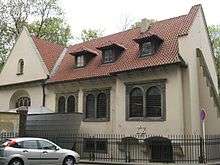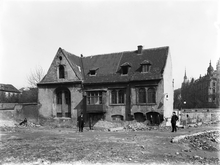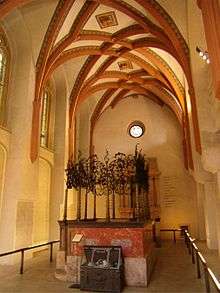Pinkas Synagogue

The Pinkas Synagogue (Czech: Pinkasova synagoga) is the second oldest surviving synagogue in Prague. Its origins are connected with the Horowitz family, a renowned Jewish family in Prague. Today, the synagogue is administered by the Jewish Museum in Prague and commemorates about 78,000 Czech Jewish victims of the Shoah.

History
An archaeological excavation has showed that in 15th century in the area of present Pinkas Synagogue there were wells, a mikveh and inhabited houses. By 1492 in one of those houses there was a private oratory belonging to a distinguished Prague Jewish family of Horowitz. In 1535 one of the family members, Aharon Meshulam Horowitz, decided to replace the house by a synagogue for his family. In this building we can find components in Gothic and Renaissance styles – for example the reticulated vault is made in the late Gothic style but its ornaments have Renaissance features and the portal is pure Renaissance. Between 1607 and 1625 an annex in Renaissance style was added and so the synagogue was extended with a vestibule, a women's section and a balcony. The architectural plan of the annex was designed by Juda Coref de Herz (the author of the plan to Maisel Synagogue, too).
The floor of the synagogue is below the ground level so it was repeatedly afflicted by floods and moisture. In the second half of 18th century it was necessary to restore aron-ha-kodesh and bimah damaged by flood and so they were changed to the Baroque style. About the same time (in 1793) successful businessman and communal leader Joachim von Popper[1] donated the synagogue with a wrought-iron Rococo grille which adorns the bimah until now. The grille is decorated with an emblem of the Prague Jewish community – Magen David with a Middle-Age Jewish hat.[2]

In 1860, a radical step was taken to solve the problem of floods – the floor level of the synagogue was raised by 1,5 m. The baroque bimah disappeared, the arrangement of the seats was modernized (seats surrounding the walls as in Old-New Synagogue were replaced by the church-like rows) and pseudo-Romanesque style dominated the space.
However, less than century later, during reconstruction in 1950–1954, the original floor-level as well as the appearance of the synagogue were restored. In following five years, walls of the synagogue were covered with names of about 78 000 Czech and Moravian Jewish victims of Shoah. The names are arranged by communities where the victims came from and complemented with their birth and death date. The memorial was designed by painters Václav Boštík and Jiří John. In 1960 it was opened to public, but it was closed after less than a decade, in 1968, after the Soviet occupation of Czechoslovakia. It was said that the reason for closing was moisture. After the fall of communistic regime in 1989 the synagogue had been reconstructed for three years and then opened to public, but it took another three years to restore the inscriptions of the names on the walls that were damaged by moisture.[3] Moreover, in 2002, an old enemy of the synagogue – flood – proved its power and the inscriptions had to be restored again.
Permanent Exhibition
On the first floor of the synagogue there is an exhibition of pictures drawn by children in the concentration camp in Theresienstadt. Children did not draw them accidentally but during drawing lessons led by Friedl Dicker-Brandeis (1898–1944), a painter, who studied at Bauhaus, Weimar. Dicker-Brandeis's experience from Bauhaus influenced the conception of her drawing lessons in Theresienstadt. She encouraged children to express themselves in drawing, to grapple with their grim experiences from the ghetto, as well as to capture their memories from home and dreams about the future. Their pictures therefore offer wide-ranged testimony about the daily reality of the ghetto and about individual children. Most of the children, as well as Friedl Dicker-Brandeis, died in Auschwitz. The only witnesses of their lives, their drawings, "survived" because Dicker-Brandeis hid them in Theresienstadt before her deportation to Auschwitz. After the war about 4,500 pictures were handed over to the Jewish Museum in Prague.[4]
Beside activities of the Museum, Pinkas Synagogue serves also the religious community.
References
- ↑ Pěkný, Tomáš (2001). Historie Židů v Čechách a na Moravě. Sefer. pp. 405–406.
- ↑ Pěkný, Tomáš (2001). Historie Židů v Čechách a na Moravě (2. ed.). Praha: Sefer. p. 86.
- ↑ Pařík, Arno (2011). Pražské synagogy = Prague Synagogues = Prager Synagogen. Prague: Jewish Museum in Prague. pp. 39–51.
- ↑ "Children's Drawings from the Terezín Ghetto, 1942–1944".
| Wikimedia Commons has media related to Pinkas Synagogue. |
Coordinates: 50°05′21″N 14°25′01″E / 50.0893°N 14.4170°E